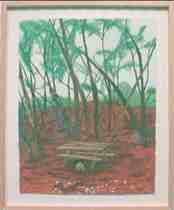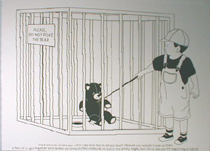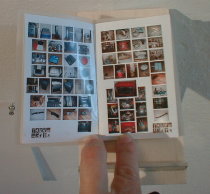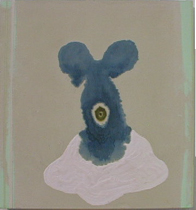 The aura of preciousness, the standard requirement for selling art, is nowhere in sight in the shows at Space 1026. The scruffy floors, the uneven lighting, the sometimes-somewhere white wall space mean a general disregard for art-world niceties like the pristine white box gallery with carefully spaced works on the wall and on pedestals and under vitrines.
The aura of preciousness, the standard requirement for selling art, is nowhere in sight in the shows at Space 1026. The scruffy floors, the uneven lighting, the sometimes-somewhere white wall space mean a general disregard for art-world niceties like the pristine white box gallery with carefully spaced works on the wall and on pedestals and under vitrines.
That doesn’t mean 1026 has nothing to offer.
And what it offers in a typical show is a dizzying exuberance and creativity, sometimes unedited, unexpurgated, and at times undigested and incomplete.
The exhibit now in place–work by art installers from the ICA, many of them accomplished and recognized artists–seems less a show and more a documentation of artistic process and effort.
(Before I go on, I want to mention the gallery talk there with the participating artists, led by Ellen Napier, Associate Director of the Fabric Workshop and Museum on Friday, July 18, 6:30 p.m.)
The process is laid bare in two group efforts–a full-wall painting to which all the artists contributed, according to show spokesman and participating artist Robert Chaney, and a 3-D installation called “The Grasshopper” (shown above), which reminded me of a melting cupcake and Cinderella’s coach and fairytale woodsman’s hut rolled into one–and if you had been there for the opening bash, you would have observed a piece of the process plus the treat of watching “The Grasshopper” roll around the space.
While both pieces have their charms–I’m especially taken with “The Grasshopper” for its windows filled with small objects unlike any knicknacks your typical woodsman would own–this is less about a refined work of art and more about artists having fun, inspiring and playing off one another.
 And that seems to be what Space 1026 is about, a cauldron for synergy, although it’s not clear to me that in this case, the level of synergy that seems to inspire the Space 1026ers transferred over to the ICAers, who have less in common with one another. But even the most diverse artists could, at times, benefit from a little shot of synergistic (is that really a word?) inspiration.
And that seems to be what Space 1026 is about, a cauldron for synergy, although it’s not clear to me that in this case, the level of synergy that seems to inspire the Space 1026ers transferred over to the ICAers, who have less in common with one another. But even the most diverse artists could, at times, benefit from a little shot of synergistic (is that really a word?) inspiration.
And those who come to look could best get that sense of creativity gone wild if they attend the opening-night happenings, like the one for this show, which included partying and music, some of it contributed by artists involved in the show.
I am not saying opening night is everything, and I’m not saying there isn’t stuff worth seeing, like the Sarah McEneaney takes on her dog (shown above right “Fort Zach. State Park, Key West, FLA,” not for sale). 
And I’m not saying there isn’t stuff worth buying, like the touching Eric McDade paintings (shown here the sad tale of stuffed animals in zoo cages).
Some other pieces I liked included Tomo’s (Takatomo Tomita) mushrooms and assorted little figures (some shown below),  Chris Hensel’s “Inventory,” a plastic-covered, sewn-together booklet with tiny pictures of all his possessions (shown below), and Clint Takeda’s small, square paintings (shown last image).
Chris Hensel’s “Inventory,” a plastic-covered, sewn-together booklet with tiny pictures of all his possessions (shown below), and Clint Takeda’s small, square paintings (shown last image).
The colors and texture of Paul Swenbeck’s rocky piles were rotten-egg weird and luscious at the same time.  Shannon Bowser’s concrete pyramids and crater on springy wire were the bobble-head versions of the wonders of nature (wait until the national park gift shops get their hands on these).
Shannon Bowser’s concrete pyramids and crater on springy wire were the bobble-head versions of the wonders of nature (wait until the national park gift shops get their hands on these).
The viewer and the buyer must face the challenge of sorting through the pictures and other works, which are hung chock-a-block, skied to neck-craning levels, the good works next to, above or below the incomplete ones, no value judgment implied by how things are placed.
Multiplying the challenge for a viewer or buyer is the lack of labeling. Is this a Joy Feasley? What’s its name? How do I buy it? Or is it even for sale? Whom do I approach about purchases? (The answer is Robert Chaney at the ICA.) How do I reach him? (The answer is email him at rchaney@pobox.upenn.edu). How do I explain which work I want to purchase? I certainly couldn’t always get across to Chaney which cartoons had caught my eye.
How do I reach him? (The answer is email him at rchaney@pobox.upenn.edu). How do I explain which work I want to purchase? I certainly couldn’t always get across to Chaney which cartoons had caught my eye.
Well, the business side of art is not Space 1026’s forte. And neither is careful display.
But what the gallery offers is precious in its own way–a free-wheeling community of artists, that puts out plenty of stuff that’s worth seeing, and also some stuff that’s still half-baked.









